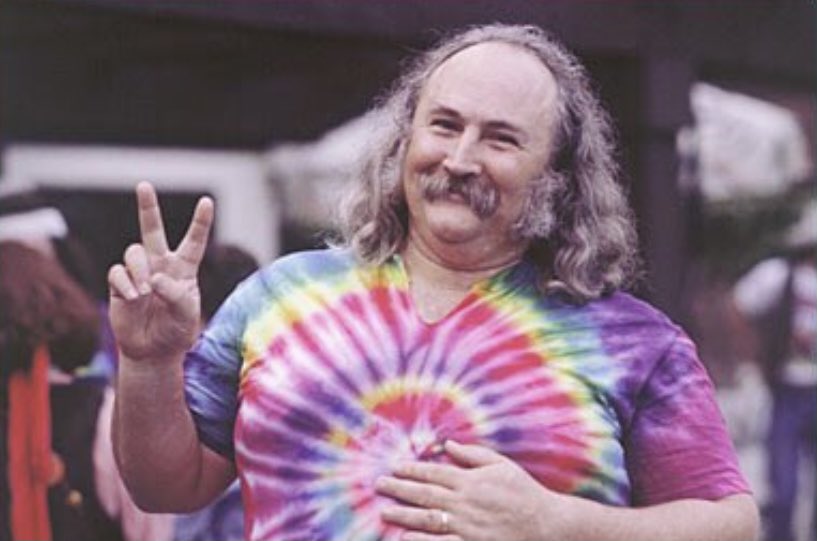David Crosby, the brash rock musician who evolved from a baby-faced harmony singer with the Byrds to a mustachioed hippie superstar and an ongoing troubadour in Crosby, Stills, Nash & (sometimes) Young, died Thursday at the age of 81, according to several media outlets.
According to the New York Times, the musician died Wednesday night, citing a text message from Crosby’s sister-in-law. Several media outlets, citing anonymous sources, reported Crosby’s death; The Associated Press could not reach Crosby’s representatives or his widow.
Crosby received a liver transplant in 1994 after decades of drug use, and he lived through diabetes, hepatitis C, and heart surgery in his 70s.
While he only wrote a few well-known songs, Crosby was at the forefront of the cultural revolution of the 1960s and 1970s, whether triumphing on stage with Stephen Stills, Graham Nash and Neil Young at Woodstock, testifying on behalf of a hirsute generation in his anthem “Almost Cut My Hair,” or mourning the assassination of Robert F. Kennedy in “Long Time Gone.”
He was a founding member and focal point of the Los Angeles rock music community, which produced artists such as the Eagles and Jackson Browne. He inspired Dennis Hopper’s long-haired stoner in “Easy Rider,” a twinkly-eyed hippie patriarch. He was an unrepentant loudmouth who engaged in personal warfare and admitted that many musicians he worked with no longer spoke to him.
“Crosby was a colorful and unpredictable character who wore a Mandrake the Magician cape, didn’t get along with too many people, and had a beautiful voice — and architect of harmony,” Bob Dylan wrote in his memoir, “Chronicles: Volume One,” published in 2004.
David Crosby’s drug use
Crosby’s drug use left him bloated, bankrupt, and estranged. He overcame his addiction during a year in prison in Texas on drug and weapons charges in 1985 and 1986. The conviction was eventually reversed.
“I’ve always said that I picked up the guitar as a shortcut to sex, and after my first joint, I was convinced that if everyone smoked dope, the war would end,” Crosby said in his 1988 autobiography, “Long Time Gone,” co-written with Carl Gottlieb. “I was correct on the sex. When it came to drugs, I was completely wrong.”
He lived years longer than expected and experienced a creative renaissance in his 70s, releasing several solo albums while collaborating with others, including his son James Raymond, who became a favorite songwriting partner.
“Most guys my age would have done a covers record or duets on old material,” he told Rolling Stone shortly before the release of “Croz” in 2013. “This isn’t going to be a big hit. It’ll most likely sell nineteen copies. I don’t think kids will like it, but I’m not going to make it for them. I’m doing it for myself. “I have some things I need to get off my chest.”
Crosby was featured in Cameron Crowe’s documentary “David Crosby: Remember My Name” in 2019.
While his solo career flourished, his seemingly lifelong bond with Nash frayed, Crosby was enraged by Nash’s 2013 memoir “Wild Tales” (which he called “whiny and dishonest”), and their relationship devolved into an ugly public feud, with Nash and Crosby agreeing on one thing: Crosby, Stills, and Nash were done.
Crosby’s rise in the music world
Crosby did express interest in a Crosby, Stills, Nash, and Young protest tour following Donald Trump’s election as President of the United States, but his former bandmates did not respond.
Crosby rose to prominence in the mid-1960s as a member of the seminal folk-rock band The Byrds, whose hits included “Turn! Turn! Turn!” and “Mr. Tambourine Man.” At the time, he was clean-cut and baby-faced, and he contributed harmonies that were an important part of the band’s innovative blend of The Beatles and Dylan. Crosby was one of the first American celebrities to become close to The Beatles and was instrumental in introducing George Harrison to Eastern music.
Crosby left The Byrds and formed a new band due to strained relationships with his bandmates. Crosby, Stills, and Nash’s first meeting is legendary: Stills and Crosby were working on the ballad “You Don’t Have to Cry” at Joni Mitchell’s house in 1968 (Stills would argue they were at Mama Cass’) when Nash suggested they start over. Nash’s high harmony added a magical layer to Stills’ rough bottom and Crosby’s mellow middle, forming a supergroup.
Their self-titled debut album was an instant success, helping to redefine commercial music. The songs were longer and more personal than their previous releases, but they were easily relatable to an audience embracing a more open lifestyle.
Their vibrant harmonies and themes of peace and love became synonymous with the late 1960s and early 1970s. Their cover of Joni Mitchell’s “Woodstock” served as the theme for a documentary about the 1969 rock concert at which the group made only its second live appearance. Crosby had produced Mitchell’s first album, “Song to a Seagull,” in 1968 and had been her boyfriend at the time (as was Nash).
Harmony and rhythm guitar
Crosby, now sporting the drooping, bushy mustache that would define him for the rest of his life, provided harmony and rhythm guitar, and his songs reflected his volatile personality. They ranged from “Guinevere’s” misty-eyed romanticism to “Deja Vu’s” spirituality to “Almost Cut My Hair’s” operatic paranoia.
Some criticized the group for being soft-headed and self-indulgent.
“If you’re into living-room rock, fireplace harmonies, and a hint of good old social consciousness, this is your band,” said Rolling Stone, who never missed an opportunity to write about the band.
But CSN, as they were soon known, won a Grammy for best new artist and became a global touring act and brand name decades later.
The first album was a lighthearted, upbeat recording, but the mood darkened during the second, “Deja Vu.” Neil Young joined the band, having feuded with Stills while both were in Buffalo Springfield and continuing to do so.
Everyone in the band was in turmoil: Nash and Mitchell had split up, as had Stills and singer Judy Collins. Meanwhile, Crosby was so devastated by the death of his girlfriend, Christine Hinton, in a car accident that he would sob on the studio floor.
Solo artists, duos, trios
The album featured a rougher, less unified sound, was released in 1970 and was another commercial success. Within two years, the quartet had disbanded, destined to reunite and splinter for the rest of their lives.
They worked as solo artists, duos, trios, and, on rare occasions, all four simultaneously. They performed in stadiums and clubs. They were present at the Berlin Wall as the Cold War ended in 1989 and in New York for the Occupy Wall Street protests in 2011.
Crosby has toured frequently in recent years and has answered questions on Twitter with affection and exasperation, whether commenting on rock star peers or assessing the quality of a fan’s marijuana joint. He loved sailing, and aside from hard drugs, his greatest regret was selling his 74-foot boat due to financial difficulties. Among the songs completed on the boat was the classic “Wooden Ships,” co-written with Stills and Paul Kantner of Jefferson Airplane.
Crosby was born David Van Cortlandt Crosby in Los Angeles on August 14, 1941. Floyd Crosby, the Oscar-winning cinematographer behind “High Noon,” was his father. His mother, Aliph, and brother, Floyd Jr., later relocated to Santa Barbara.
Crosby grew up listening to classical, folk, and jazz music. Crosby stated in his autobiography that as a child, he used to harmonize while his mother sang, his father played mandolin, and his brother played guitar.
“I wasn’t into it when rock ‘n’ roll came in during that era, and the Age of Elvis possessed America,” he recalled.
The Beatles inspired Crosby.
His brother taught him to play the guitar, and he began performing in Santa Barbara clubs while still in his teens. In 1960, he moved to Los Angeles to study acting but dropped out and became a folk singer, touring the country before joining The Byrds. Like many other folk performers, Crosby was inspired by the Beatles’ 1964 film “A Hard Day’s Night” and decided to pursue a career as a rock star.
In 1987, Crosby married his longtime girlfriend, Jan Dance. Django, the couple’s son, was born in 1995. Crosby and Debbie Donovan had a daughter, Donovan. Crosby was reunited with Raymond, who had been placed for adoption in 1961, shortly after undergoing the liver transplant. Raymond, Crosby, and Jeff Pevar later formed a band called CPR.
“I regretted losing him many times,” Crosby said of Raymond in 1998 to the Associated Press. “I was too immature and irresponsible to parent anyone.”
Melissa Etheridge revealed in 2000 that Crosby was the father of her two children with then-partner Julie Cypher. Etheridge told Rolling Stone that Cypher carried the children Crosby fathered through artificial insemination. Beckett, one of the sons, died in 2020.
David Crosby did not assist in raising the children but stated, “If, you know, in time, at a distance, they’re proud of who their genetic father is, that’s great.”
Source: AP














